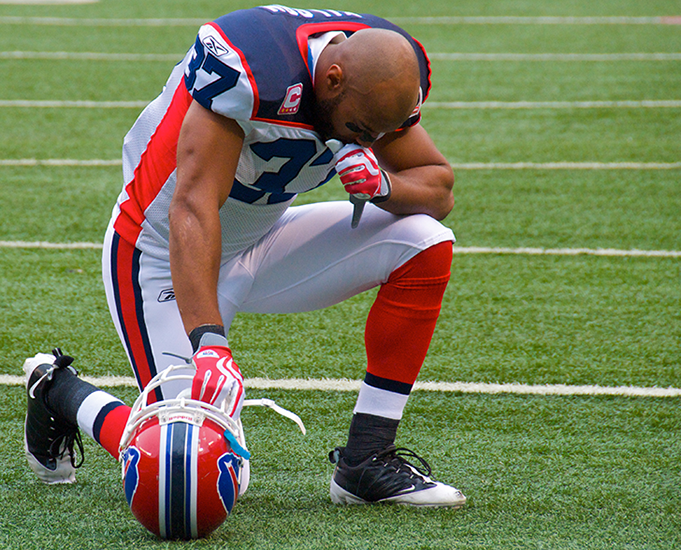Using Sport to Teaching American Religious History
Introduction
I began studying the relationship between religion and sports in the United States as a graduate student because I was interested in investigating the religious underpinnings and implications of popular culture. As I dug into the literature on religion and sports and conducted my own research on contemporary Christian athletes, I noticed an interesting historical trend: since at least the late 19th century, religious Americans have turned to sport to strengthen both the American and the religious aspects of their identity; and their practices and descriptions can reveal cultural understandings of what it means to be religious and what it means to be American—two important topics for courses on religion in America. Over the past several years of teaching about religion in the United States, I have found that including a unit on religion and sports provides an accessible and exciting way to engage students on questions of identity, community, and American culture.
A central theme of my courses, and of many courses on religion in the United States, is the establishment and maintenance of Protestant dominance in American life. Scholars have noted that the American legal system uses a Protestant Christian prototype to define religion, inherently privileging forms of religion that adhere to Protestant norms (private, voluntary, individual, textual, and believed) over others (that may be public, coercive, communal, oral, or enacted). This privileging becomes clear when we compare Protestant and non-Protestant religious groups and examine how non-Protestant religions adapt to American culture. Catherine Albanese’s popular textbook on religion in America, America: Religions and Religion (2012), calls this the “manyness” and the “oneness” of American religions. While the United States has consistently demonstrated religious diversity, both through innovation and immigration, its religiosity also tends to adhere to Protestant definitions of what counts as “religious.” For example, non-Protestant religious immigrants to the United States tend to adopt a congregational model of religious practice regardless of whether this was their practice in their previous home. As scholars and teachers of religion in America have emphasized, paying attention to the privileging of Protestantism is crucial for examining lived religion in the United States. There are, of course, many means of achieving this goal. This article makes a case for using the history of US sports to provide students with an accessible example of how Protestants exerted and maintained cultural dominance.
Sports History is Religious History
Let me tell you the story I tell my students. Sports and religion did not always go hand in hand in the United States. Today, it is common to see Christian athletes thanking God in post-game interviews or for American children to attend Christian summer camps that focus on athletic training; but for much of US history, Christians were skeptical of sports’ benefits and deeply suspicious that playing sports ran counter to Christian values. Christians in the 18th and early 19th centuries saw sport as a dangerous leisure activity likely to distract Christians from church and tempt them with vices like gambling, alcohol, womanizing, and violence. Many states passed laws banning the playing of sports on Sundays, demonstrating the idea that sport contradicted and perhaps undermined Christian priorities. So, what changed? How did the United States move from a stance of seeing religion and sport as contradictory to a stance of seeing religion and sport as compatible, perhaps even mutually beneficial?
One answer to this question is the social movement of muscular Christianity, a turn-of-the-century Protestant movement that emphasized a Christian commitment to health and manliness. Muscular Christians developed institutions like the YMCA and Boy Scouts of America; they invented the sport of basketball; and they were extremely influential in the normalization of physical education in schools and summer camp curricula. When teaching about muscular Christianity, I emphasize the social context of the movement—a time of rapid industrialization, urbanization, and immigration—in order to show American Protestant anxiety over their increasingly fragile position of cultural dominance. These Protestants turned to sport as an affirmation of masculinity and power. I ask the students to think about how the legacies of muscular Christianity (physical education, the idea that “sport builds character,” and the affirmation of masculinity) shift from being “Protestant values” to “American values.” I have had much success having students discuss their own summer camp or team sport experiences from a critical perspective as they begin to question who benefits from the institutionalized disciplinarity of sports participation?
Once I have covered muscular Christianity, I introduce the students to the largest religious immigrant groups who were arriving in the United States at the time—Jews and Catholics. We discuss how many Jews and Catholics embraced sports in order to demonstrate (to the dominant Protestant establishment) that they were capable of becoming fully American. For example, Jews developed institutions such as the Young Men’s Hebrew Association modeled on muscular Christianity’s YMCA. Through these activities, American Jews sought to negotiate between preserving their values of intellectualism and community while concurrently engaging in the embodied and often individualistic project of sports. We also discuss anti-Semitism and look at the Black Sox Scandal of 1919. Prominent Americans like Henry Ford blamed the Jewish gamblers who organized the thrown World Series more than the players who participated in it, and Ford publicly argued that Jews were ruining America by undermining America’s pastime of baseball. I connect this sentiment of anti-Semitism to the change of immigration laws in 1924 that severely limited Jewish and Catholic immigration. Much of this history is new territory for my students and thinking about anti-Catholic and anti-Semitic discrimination through the lens of sports helps to ground them in this history.
In much the same way that American Jews turned to sports to demonstrate their belonging in America, the Catholic diocese of Philadelphia was especially keen on sports programming. I assign Julie Byrne’s (2003) work, O God of Players: The Story of the Immaculata Mighty Macs, as a case study to show how Catholics embraced the ideals of muscular Christianity and modified these ideals for women. Shifting our attention to address explicitly women in sport complicates the narrative of masculinity as a source of power. For Catholic women like those on the Mighty Macs, playing sports required emphasizing and over-emphasizing femininity in order to show that playing sport could be appropriate for women. I return here to the muscular Christian idea of sport as a way to “turn boys into men”—women had to negotiate sport very carefully to combat the underlying logic that sport would turn girls into men.
I conclude the unit on sports with two examples of sport and Islam in the United States. Using Muhammad Ali’s conversion to Nation of Islam and his refusal to fight in Vietnam, I cover themes of religious resistance, politicized religion, and religion and race. While most of my students are familiar with Muhammad Ali as a Parkinson’s sufferer and a famous boxer, they are often unaware of his affiliation with a radical separatist religious movement and his plea for conscientious objector status. Pairing Muhammad Ali’s story with Julie Byrne’s work allows us to discuss the role of religion and sports in what Byrne calls the pleasure of standing out and the pleasure of fitting in. Like the Immaculata Mighty Macs, Muhammad Ali saw himself as a public role model for his religion and experienced conflicting pressures to fit into his religious community and to fit into American culture. The controversy surrounding his draft evasion brings these issues to the fore.
As a second example, I have the students watch a documentary about a majority Muslim high school football team in Dearborn, Michigan called Fordson: Faith, Fasting, and the American Dream (2011). The documentary follows the team during the month of Ramadan and raises questions about assimilation, religious community, and what it means to be American. This documentary allows me to return to many of the themes that emerged when we talked about Jewish immigrants’ embrace of muscular Christian practices, and the students are able to see that muscular Christian values (i.e., Protestant norms) are still incredibly influential in the contemporary United States.
Sport as a Cultural Lens
In my teaching, sport has been useful for connecting my students to major trends in American religious history. Because many students have had experiences with sports, they can better humanize this range of religious traditions. Like the study of religion, the study of sport can be a fruitful place to illuminate and investigate intersectionality—the overlapping power structures that inform our society and world. Sport is certainly not the only slice of culture that can raise these issues and provoke these conversations, but what I have found especially helpful about sport is that, for many students, sport is a part of their lives and culture that they treat as normal, natural, and static. Spending some time thinking about sport as cultural work in progress, fraught with power struggles, and examining how dominant and minority groups have contributed to our now black-boxed understanding of sport as “character-building” teaches students to ask really important questions: what are we taking for granted? What goes without saying? What are the effects of this unquestioned knowledge? Who benefits and who struggles?
At the end of the course, I want to students to understand that many of what they commonly think of as “American values” have roots in Protestantism, and therefore these “American values” privilege certain ways of being religious over others. Using sports to explore the American religious landscape engages students in thinking through an aspect of American culture that they often take for granted, and I have had much success in using sport to help students see the influence of Protestantism on American cultural norms and values.
Resources
Brookfield, Stephen. 2015. The Skillful Teacher: On Technique, Trust, and Responsiveness in the Classroom. San Francisco: Jossey-Bass.
Carp, Richard. 2007. “Teaching Religion and Material Culture” Teaching Theology and Religion 10:1, 2–12.
Murphy, Tim. 2006. “Cultural Understandings of ‘Religion’: The Hermeneutical Context of Teaching Religious Studies in North America.” Method and Theory in the Study of Religion. 18:3, 197–218.
Other References
Albanese, Catherine L. 2012. America: Religions and Religion. 5th ed. Boston, MA: Wadsworth.
Byrne, Julie. 2003. O God of Players: The Story of the Immaculata Mighty Macs. New York: Columbia University Press.
Ghazi, Rashid. 2011. Fordson: Faith, Fasting, and the American Dream. North Shore Films.
 Annie Blazer is an assistant professor of religious studies at the College of William and Mary. Her courses cover religion in America from the colonial to the contemporary period. In particular, Blazer's courses investigate the relationship between religion and popular culture, paying attention to race, class, gender, and sexuality. Her first book, Playing for God: Evangelical Women and the Unintended Consequences of Sports Ministry (NYU Press, 2015), is an ethnographic exploration of the religious experiences of contemporary Christian athletes in the United States. Blazer serves as cochair of the Religion, Sport, and Play Group for the American Academy of Religion and has also published scholarship on sports media, foodways, and teaching and learning in religious studies.
Annie Blazer is an assistant professor of religious studies at the College of William and Mary. Her courses cover religion in America from the colonial to the contemporary period. In particular, Blazer's courses investigate the relationship between religion and popular culture, paying attention to race, class, gender, and sexuality. Her first book, Playing for God: Evangelical Women and the Unintended Consequences of Sports Ministry (NYU Press, 2015), is an ethnographic exploration of the religious experiences of contemporary Christian athletes in the United States. Blazer serves as cochair of the Religion, Sport, and Play Group for the American Academy of Religion and has also published scholarship on sports media, foodways, and teaching and learning in religious studies.
Image: George Wilson, safety for the Buffalo Bills (American football), prays before a game against the New York Jets. By Ed Yourdon (Flickr: NY Jets vs. Buffalo, Oct 2009 - 02), via Wikimedia Commons

